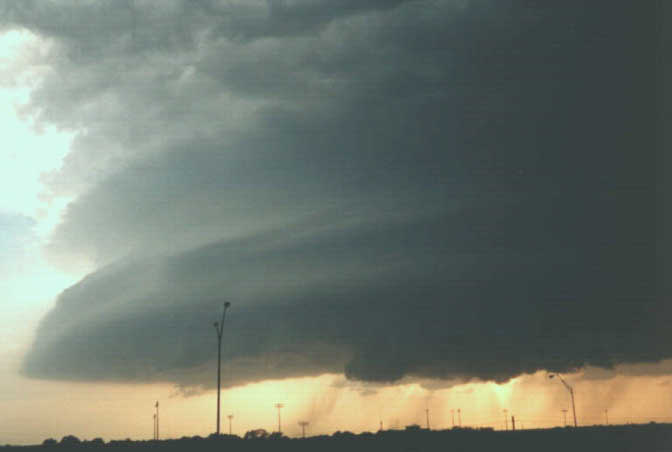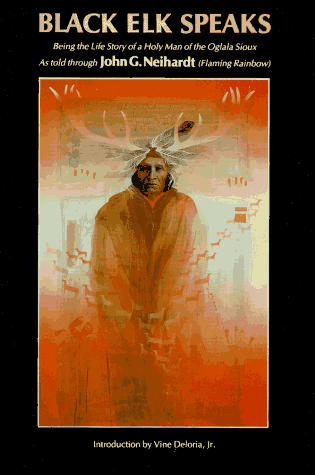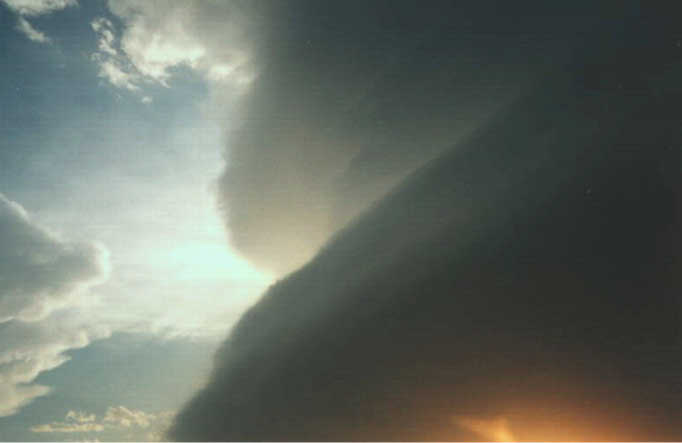
Steve Miller is a Texas stormchaser who follows severe storms around the southern Great Plains. On June 13, 1998, he wrote a chase report about a huge mesocyclone that formed over Oklahoma City, saying, “The swirling rotation was really beautiful within the entire cloud structure…a symphony of delicate and smooth, fluid motions.”
The mesocyclone continued to rotate and increase in size, until finally it backed up over the heads of the stormchasers who were watching it, spellbound. Wrote Miller (on a stormchaser website that no longer exists), “The back edge of the meso[cyclone] is just about overhead. Words and pictures cannot describe nor capture the sensation of this moment…it was very surreal…a religious experience to say the least.” The photograph he took, which accompanied those words, is above.
Stormchasers know that there’s more to trying to catch a glimpse of a tornado than the adrenaline rush. They also know that a lot of people suspect as much, and worry that people without training will be so mesmerized by the power of the storms that they’ll inadvertently put themselves in harm’s way. Stormchaser websites commonly express the ambiguous tension between sharing what is essentially a mystical and powerful experience with others, while at the same time warning them not to partake of it themselves without instruction. Such warnings range from funny to formal.
Native Americans lived with tornadoes and severe storms on the Great Plains for thousands of years before stormchasers came along. Because they practice nature-centered spirituality they did and do see the spiritual aspects of storms, including tornadoes. The writings of Oglala Lakota holy man Black Elk, who was a boy at the battle of Greasy Grass (Little Big Horn) and a distant relative of Crazy Horse, tell of a religious vision he received in which he rode upon such a storm.
Vine Deloria says in his introduction to the book “Black Elk Speaks,” in which John Neihardt transcribed Black Elk’s recounting of his vision, that his works comprise a sort of canon for North American Indian theological tradition. His vision therefore comprises a spiritual way of knowing — in this case about severe storms of the type that would generate a tornado.
 In his vision, Black Elk rides upon a bay horse, high above the earth among a herd of twelve great black horses (and other spirit warriors and horses). Black is a symbol of the west — the direction from which thunderstorms sweep down across the prairie. In his vision, he finds a blue man who holds the land in a terrible drought, and slays him. This releases life-giving rain from the storm, restoring the land, plants, and animals.
In his vision, Black Elk rides upon a bay horse, high above the earth among a herd of twelve great black horses (and other spirit warriors and horses). Black is a symbol of the west — the direction from which thunderstorms sweep down across the prairie. In his vision, he finds a blue man who holds the land in a terrible drought, and slays him. This releases life-giving rain from the storm, restoring the land, plants, and animals.
“Black Elk Speaks” was first published in 1932, and has been reprinted several times since then. The lengthy quote that follows is from pages 31-33 of the 1979 edition published by the University of Nebraska Press, Lincoln.
“I looked below me where the earth was silent in a sick green light, and saw the hills look up afraid and the grasses on the hills and all the animals; and everywhere around me were the cries of frightened birds and sounds of fleeing wings. I was the chief of all the heavens riding there and when I looked behind me, all the twelve black horses reared and plunged and thundered and their manes and tails were whirling hail and their nostrils snorted lightning. And when I looked below again, I saw the slant hail falling and the long, sharp rain, and where we passed, the trees bowed low and all the hills were dim.”Now the earth was bright again as we rode. I could see the hills and valleys and the creeks and rivers passing under. We came above a place where three streams made a big one — a source of mighty waters — and something terrible was there. Flames were rising from the waters and in the flames a blue man lived. The dust was floating all about him in the air, the grass was short and withered, the trees were wilting, two-legged and four-legged beings lay there thin and panting, and wings too weak to fly.
“Then the black horse riders shouted “Hoka hey!” and charged down upon the blue man, but were driven back. And the white troop shouted, charging, and was beaten; then the red troop and the yellow.
“And when each had failed, they all cried together: ‘Eagle Wing Stretches, hurry!’ And all the world was filled with voices of all kinds that cheered me, so I charged. I had the cup of water in one hand and in the other was the bow that turned into a spear as the bay and I swooped down, and the spear’s head was sharp lightning. It stabbed the blue man’s heart, and as it struck I could hear the thunder rolling and many voices that cried ‘Uh-hee!,’ meaning I had killed. The flames died. The grass and trees were not withered any more and murmured happily together, and every living being cried in gladness with whatever voice it had. Then the four troops of horsemen charged down and struck the dead body of the blue man, counting coup; and suddenly it was only a harmless turtle.
“You see, I had been riding with the storm clouds, and had come to earth as rain, and it was drouth that I had killed with the power that the Six Grandfathers gave me. So we were riding on the earth now down along the river flowing full from the source of waters…”
It’s important to understand that this view of tornadoes and severe weather has not died, despite the assumptions of many non-Native people. Native cultures are still vital and active, and Elders continue to teach us all. After the May, 2013 tornadoes of Oklahoma City and Moore, Oklahoma, journalist Sam Anderson of The New York Times wrote a long piece entitled “The Weather God of Oklahoma City” (August 9, 2013) about legendary Oklahoma meteorologist Gary England. In this article, Anderson digresses from his exploration of modern meteorological science to report on a Cheyenne Elder’s worldview regarding tornadoes — and his sacred relationship to them. Here is the passage, quoting Gordon Yellowman (reprinted here with the understanding that Mr. Yellowman would not have agreed to be interviewed by a journalist unless he was willing for his wisdom to be shared in a public forum such as this one):
“In the weeks after the May 31 tornado, I kept remembering something Gary England told me in his office. One big regret, he said, is that although he grew up surrounded by Cheyenne people in Seiling, he never asked them about tornadoes. He didn’t know any of the tribes’ severe-weather folklore or survival strategies — the wisdom they must have built up over centuries on the Plains. Greg Carbin, at the National Weather Service, told me something similar. It’s a shame, he said, but not much native lore has survived. Both men had an attitude of sad resignation. Despite all of our Dopplers and Storm Trackers and Dominators, the feeling seemed to be, we have lost the old wisdom forever.
“As I combed through the meteorological data about the tornadoes of May 31, this loss kept cycling through my mind. Eventually, in mid-July, after Oklahoma’s tornado season had given way to suffocating summer heat, I e-mailed the Cheyenne Nation and got in touch with a chief named Gordon Yellowman. Yellowman wouldn’t tell me everything he knows about surviving tornadoes. The rituals are sacred, he said, and have never been shared with outsiders. But he did tell me some things.
“The Cheyenne language has several words for tornadoes and their related storms: hevovetaso (tornado), ma’xehevovetaso (big whirlwind), ehohaatamano’e (threatening weather). For the Cheyenne, the tornado is not some kind of evil predatory force or a random assault from a blind and dumb atmospheric soup with no concern for human life. A tornado has a job, Yellowman told me, and that is to restore balance to the environment. The tornado speaks to the native people, in their respective tribal languages, in a voice that sounds like fire. Before it reaches the tribal land, the tornado tells the elders how big it’s going to be, not in the technical language of the EF scale but in colloquial terms: small, medium, big, huge. The tornado of May 31 was huge.
“Yellowman is 55 and lives in El Reno. Late on the afternoon of May 31, as the EF5 was bearing down on his city, he and four other Cheyenne holy men stood in their homes and enacted the ancient rituals. They spoke with the tornado. They asked it to have pity and turn away. This, Yellowman said, was when, against all meteorological expectation, the tornado turned south — baffling Gary England . . . It was later determined that the El Reno tornado was 2.6 miles wide — the widest in recorded history.”
We see in these words of Gordon Yellowman and those of Black Elk the same sort of powerful ambiguity that was present in the stormchasers’ words and lives: that here is a thing monumentally bigger and more powerful than the living creatures of earth, and yet a thing that bears within it the seeds of life and balance. Without the storms, there is drought and destruction that is eternally fatal. The black storms of the west are terrifying, powerful — and, because they bring rain, absolutely essential to life.

This is why the west is considered such a powerful direction to the plains Indian people in particular, and why we have chosen to represent spiritual ways of knowing on the black, west portion of the sacred circle Tapestry uses to explain different ways of knowing.
What does this mean to you, in terms of what you should do if you find that a tornado or severe storm is nearby? Perhaps at the instant of making a decision, the only thing it will bring you is a sense of participating in something much greater than the moment. However, the more important understanding it may bring is in how you think about tornadoes and keeping safe from them in general. It would be easy to see tornadoes as evil things that should be controlled, avoided at all cost, even hated. There are people who refuse to live in the central parts of North America for fear of tornadoes.
If you think about what you can learn about tornadoes spiritually, however, you might find yourself wondering what else in our lives bears this same powerful ambiguity. Is this the only event over which humans have no power, or are there others? If so, do they bring with them the same disturbing and awe-inspiring mix of both terror and spiritual understanding that defies words — about our place in nature and nature’s place in our lives? What do these things mean for us, a people who have begun to believe we can control nature and protect ourselves from anything bigger than ourselves?
The possibilities for new understanding grow like a thunderhead on a hot May afternoon.
Continue to Mythic Ways of Knowing and Learning About Tornadoes.
Return to Spiritual Ways of Knowing and Learning.
You may use the table below to explore the directions, their associated ways of knowing and learning, and an example of each type of learning as applied to understanding tornadoes.

